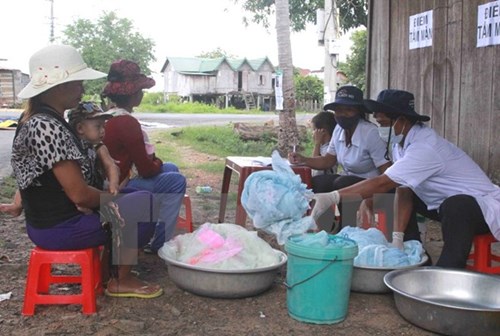The call comes amid concern over resistance of malaria parasites to anti-malarial drugs, including artemisinin— the core compound of the best available anti-malarial medicines. To date, resistance has been detected in five of the six GMS countries: Cambodia, the Lao People’s Democratic Republic, Myanmar, Thailand and Vietnam. The best way to address the threat posed by drug-resistance is to eliminate malaria altogether from the countries of the Mekong.
    |
 |
| Amid concern over drug resistance, Mekong countries call for accelerated action to eliminate malaria by 2030. Photo for illustration: vietnamplus |
At a high-level meeting convened by the Ministry of Health of Myanmar in collaboration with the World Health Organization (WHO) and the Asia Pacific Leaders Malaria Alliance (APLMA), representatives from the six countries’ stressed that eliminating malaria in the Sub-region requires urgent and coordinated action, with support from implementing agencies, funders and other partners.
The meeting pledged to:
- ensure activities to eliminate malaria in the sub-region are fully funded, including with more domestic funds;
- improve cross-border collaboration and establish an independent oversight body, for which WHO will act as the secretariat;
- strengthen systems for the identification and timely reporting of malaria infections, including drug-resistant forms;
- provide the best possible prevention, diagnosis and care for all people at risk of malaria, including free services for ethnic minorities and mobile and migrant populations, as part of universal health coverage;
- ensure available anti-malarial medicines are safe and effective for use;
- bring all concerned sectors together to translate policies into time-bound and results-oriented actions; and
- engage communities in malaria elimination using innovative communication tools.
Countries requested support from WHO to achieve their malaria elimination goals.
“Malaria is a disease that we can, and must, eliminate from the Greater Mekong Sub-region. The drive to achieve this goal by 2030 demonstrates the joint commitment of health leaders from across the Sub-region to secure the health and well-being of vulnerable populations and ensure no one is left behind,” said Dr. Poonam Khetrapal Singh, WHO Regional Director for Southeast Asia.
“The Anopheles mosquito does not need a passport or a visa to cross borders. You must work more closely together as one region, with one strategy to drive elimination. Accelerating malaria elimination in the Greater Mekong will not only improve lives today. It will also free future generations from the plague of malaria, and set an example for the rest of the world,” said Dr. Shin Young-soo, WHO Regional Director for the Western Pacific.
WHO helps governments achieve malaria elimination by:
- setting and disseminating guidance and policies on malaria control and elimination;
- supporting countries as they adapt, adopt and implement WHO global norms and standards for malaria control and elimination;
- assisting countries in the implementation of national malaria strategic plans;
- helping countries develop robust malaria surveillance systems;
- responding to requests from countries to address threats, operational emergencies and bottleneck issues.
Recent efforts to fight malaria in the GMS have yielded impressive results. According to the latest WHO estimates, malaria cases in the six countries fell by an estimated 74% between 2012 and 2016. Deaths due to malaria fell by 91% over the same period.
This progress was made possible through greater access to effective malaria control tools, particularly artemisinin-based combination therapies for malaria treatment, rapid diagnostic tests, and insecticide-treated nets. Since 2012, targeted provision of these tools to vulnerable populations has increased substantially across the sub-region, leading to acceleration in the pace of progress. Resistance to anti-malarial drugs, unless addressed with urgency, could undermine these gains.
Malaria is a life-threatening disease caused by Plasmodium parasites that are transmitted to people through the bites of infected female Anopheles mosquitoes. WHO-recommended malaria control tools include: long-lasting insecticidal bed-nets, spraying inside walls of dwellings with insecticides, preventive treatment for infants and during pregnancy, prompt diagnostic testing, and treatment of confirmed cases with effective anti-malarial medicines.
| Current situation in Vietnam:
Vietnam has made significant progress towards eliminating malaria in recent years.Compared with 10 years ago (2006), cases of malaria in Vietnam have decreased by 81.6%, and deaths have reduced by 92.7%. In 2016 there were 4,161 cases of malaria in the country, with 3 deaths. This impressive decrease was made possible through the strong commitment and substantial investments in malaria control of the Government of Vietnam and its international development partners.
The Government of Vietnam is strongly committed to the goal of malaria elimination by 2030 in Vietnam through the National Strategy for Malaria Control and Elimination in the Period 2011-2020 and orientation to 2030.
The issue of multidrug resistance in the Greater Mekong Sub-region (GMS), including in Vietnam, has been well known to WHO for a number of years. In 2015 and 2016, 4 studies conducted by Vietnam’s National Malaria Control Program (NMCP), in collaboration with WHO, already demonstrated high treatment failure rates with dihydro-artemisinin-piperaquine (DHA-PIP) in Binh Phuoc province. DHA-PIP is the most commonly used treatment for malaria in Vietnam. Since then Vietnam has worked closely with international partners to respond to the threat of artemisinin-resistant malaria in line with international WHO recommendations. |
Reported by Thu Nguyen